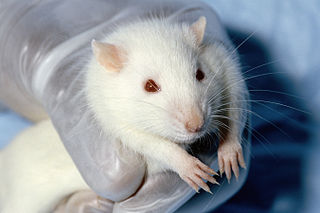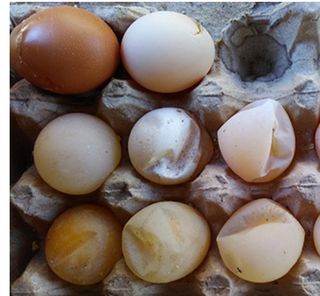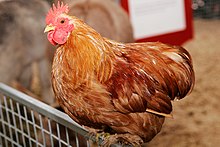
Avian influenza, also known as avian flu, is a bird flu caused by the influenza A virus, which can infect people. It is similar to other types of animal flu in that it is caused by a virus strain that has adapted to a specific host. The type with the greatest risk is highly pathogenic avian influenza (HPAI).
In birds, the bursa of Fabricius is the site of hematopoiesis. It is a specialized organ that, as first demonstrated by Bruce Glick and later by Max Dale Cooper and Robert Good, is necessary for B cell development in birds. Mammals generally do not have an equivalent organ; the bone marrow is often the site of both hematopoiesis and B cell development. The bursa is present in the cloaca of birds and is named after Hieronymus Fabricius, who described it in 1621.
Poultry diseases occur in poultry, which are domesticated birds kept for their meat, eggs or feathers. Poultry species include the chicken, turkey, duck, goose and ostrich.

Infectious bursal disease (IBD), also known as Gumboro disease, infectious bursitis, and infectious avian nephrosis, is a highly contagious disease of young chickens and turkeys caused by infectious bursal disease virus (IBDV), characterized by immunosuppression and mortality generally at 3 to 6 weeks of age. The disease was first discovered in Gumboro, Delaware in 1962. It is economically important to the poultry industry worldwide due to increased susceptibility to other diseases and negative interference with effective vaccination. In recent years, very virulent strains of IBDV (vvIBDV), causing severe mortality in chicken, have emerged in Europe, Latin America, South-East Asia, Africa, and the Middle East. Infection is via the oro-fecal route, with affected birds excreting high levels of the virus for approximately 2 weeks after infection. The disease is easily spread from infected chickens to healthy chickens through food, water, and physical contact.
Avian coronavirus is a species of virus from the genus Gammacoronavirus that infects birds; since 2018, all gammacoronaviruses which infect birds have been classified as this single species. The strain of avian coronavirus previously known as infectious bronchitis virus (IBV) is the only coronavirus that infects chickens. It causes avian infectious bronchitis, a highly infectious disease that affects the respiratory tract, gut, kidney and reproductive system. IBV affects the performance of both meat-producing and egg-producing chickens and is responsible for substantial economic loss within the poultry industry. The strain of avian coronavirus previously classified as Turkey coronavirus causes gastrointestinal disease in turkeys.
Marek's disease is a highly contagious viral neoplastic disease in chickens. It is named after József Marek, a Hungarian veterinarian who described it in 1907. Marek's disease is caused by an alphaherpesvirus known as "Marek's disease virus" (MDV) or Gallid alphaherpesvirus 2 (GaHV-2). The disease is characterized by the presence of T cell lymphoma as well as infiltration of nerves and organs by lymphocytes. Viruses related to MDV appear to be benign and can be used as vaccine strains to prevent Marek's disease. For example, the related herpesvirus found in turkeys (HVT), causes no apparent disease in the birds, and continues to be used as a vaccine strain for prevention of Marek's disease.

Chicken anemia virus, or CAV, is currently a member of the Anelloviridae family which is found worldwide. The virus only affects chickens. CAV is a non-enveloped icosahedral single stranded DNA virus, which causes bone marrow atrophy, anemia, and severe immunosuppression. Clinical signs of CAV infection are predominantly found in young chicks due to vertical transmission from the breeder hens whose maternal antibodies have not yet formed following exposure. Clinical disease is rare today because of the widespread practice of vaccinating breeders, but the subclinical form of the disease—which normally affects birds more than two weeks of age following horizontal transmission of the virus via the fecal–oral route—is ubiquitous. The virus is very resistant in the environment, making elimination very difficult.
Aviadenoviruses are adenoviruses that affect birds—particularly chickens, ducks, geese, turkeys and pheasants. There are 15 species in this genus. Viruses in this genus cause specific disease syndromes such as Quail Bronchitis (QB), Egg Drop Syndrome (EDS), Haemorrhagic Enteritis (HE), Pheasant Marble Spleen Disease (MSD), and Inclusion Body Hepatitis (IBH). Avian adenoviruses have a worldwide distribution and it is common to find multiple species on a single farm. The most common serogroups are serogroup 1, 2 and 3.
Alpharetrovirus is a genus of the family Retroviridae. It has type C morphology. Members can cause sarcomas, other tumors, and anaemia of wild and domestic birds and also affect rats.
In molecular biology, insertional mutagenesis is the creation of mutations in DNA by the addition of one or more base pairs. Such insertional mutations can occur naturally, mediated by viruses or transposons, or can be artificially created for research purposes in the lab.
Leucosis is a leukemia-like malignant viral disease that is found in animals, particularly poultry and cattle.

Specific-pathogen-free (SPF) is a term used for laboratory animals that are guaranteed free of particular pathogens. Use of SPF animals ensures that specified diseases do not interfere with an experiment. For example, absence of respiratory pathogens such as influenza is desirable when investigating a drug's effect on lung function.
Gyrovirus is a genus of viruses, in the family Anelloviridae. Until 2011, chicken anemia virus was the only Gyrovirus identified, but since then gyroviruses have also been identified in humans. Diseases associated with this genus include: chicken infectious anemia, which is associated with depletion of cortical thymocytes and erythroblastoid cells.
Avian sarcoma leukosis virus (ASLV) is an endogenous retrovirus that infects and can lead to cancer in chickens; experimentally it can infect other species of birds and mammals. ASLV replicates in chicken embryo fibroblasts, the cells that contribute to the formation of connective tissues. Different forms of the disease exist, including lymphoblastic, erythroblastic, and osteopetrotic.

Histomoniasis is a commercially significant disease of poultry, particularly of chickens and turkeys, due to parasitic infection of a protozoan, Histomonas meleagridis. The protozoan is transmitted to the bird by the nematode parasite Heterakis gallinarum. H. meleagridis resides within the eggs of H. gallinarum, so birds ingest the parasites along with contaminated soil or food. Earthworms can also act as a paratenic host.
Avian orthoreovirus, also known as avian reovirus, is an orthoreovirus from the Reoviridae family. Infection causes arthritis and tenosynovitis in poultry. It can also cause respiratory disease.
The avian immune system is the system of biological structures and cellular processes that protects birds from disease.

Egg drop syndrome '76 is a viral disease that affects birds, notably chickens, ducks, geese and swans. It is characterised by a sudden drop in production of eggs as well as its eggshell quality in apparent healthy laying birds.
Reticuloendotheliosis (RE) designates a group of pathologic syndromes caused by the reticuloendotheliosis virus (REV) group of avian retroviruses. The disease syndromes associated with REV include 1) a runting disease syndrome, 2) chronic neoplasia of lymphoid and other tissues, and 3) acute reticulum cell neoplasia.

The Houghton Poultry Research Station was a poultry disease research station in northern Cambridgeshire.







